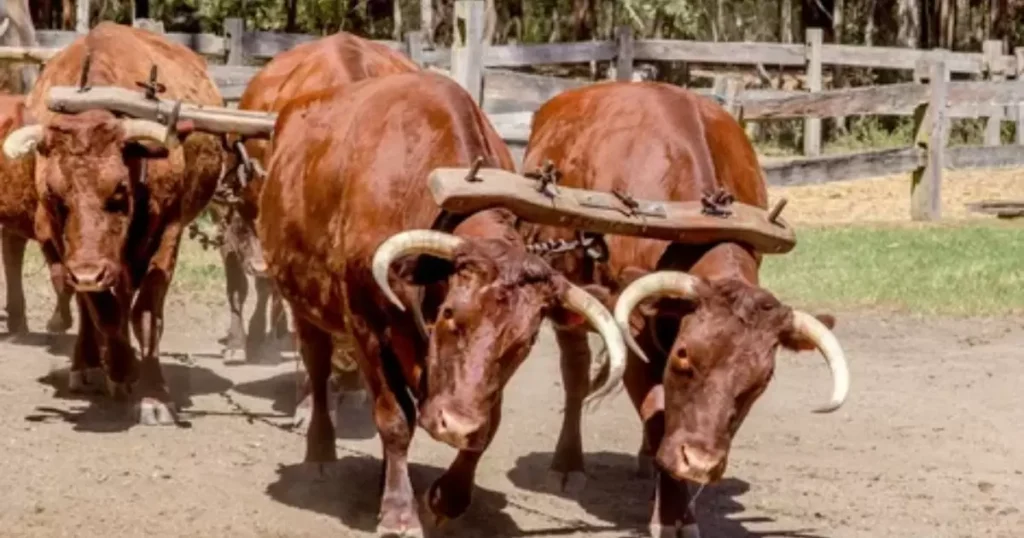Oxen, the powerful and sturdy bovine animals traditionally used for plowing and hauling, have been an essential part of agriculture for centuries. When seen together in a group, these impressive creatures are described using various collective nouns, each offering insight into their behavior and purpose.
n this article, we will explore the concept of collective nouns and delve into some interesting examples specifically related to oxen.
What Are Collective Nouns?
Collective nouns are words used to describe a group of individuals or things considered as a single entity. These nouns simplify our language and provide a more vivid and interesting way to refer to collections of objects, animals, or people.
For example, instead of saying “a group of birds,” we can say “a flock of birds,” which is more expressive and efficient.
Best Collective Nouns for Oxen
- A team of oxen
- A yoke of oxen
- A drove of oxen
- A herd of oxen
- A pair of oxen
- A string of oxen
- A span of oxen
- A draft of oxen
- A plow of oxen
- A chain of oxen
Let’s explore each of these collective nouns in more detail.
A Team of Oxen
Explanation
A “team of oxen” refers to a group of oxen working together, typically harnessed to a plow or wagon.
Scenario
The farmer guided a team of oxen through the field, preparing the soil for planting.

A Yoke of Oxen
Explanation
A “yoke of oxen” denotes a pair of oxen harnessed together by a yoke, often used for pulling heavy loads.
Scenario
In ancient times, a yoke of oxen was a common sight on farms, performing essential tasks to sustain the community.
A Drove of Oxen
Explanation
A “drove of oxen” signifies a large group of oxen being driven or herded from one place to another.
Scenario
The cattle herder guided a drove of oxen along the dusty trail, their hooves kicking up clouds of dust.
A Herd of Oxen
Explanation
A “herd of oxen” is a general term used to describe a group of oxen gathered together, whether for work or grazing.
Scenario
A herd of oxen grazed peacefully in the pasture, their bellows echoing across the countryside.
A Pair of Oxen
Explanation
A “pair of oxen” refers to two oxen working or traveling together, often seen as a complementary team.
Scenario
The farmer hitched a pair of oxen to the cart, ready to transport goods to the market.
A String of Oxen
Explanation
A “string of oxen” emphasizes the linear arrangement of oxen when harnessed together, especially in a draft or procession.
Scenario
The wagon train stretched across the prairie, each cart pulled by a string of oxen.
A Span of Oxen
Explanation
A “span of oxen” is a term used to describe a pair of oxen specifically harnessed for pulling a wagon or plow.

Scenario
The pioneers relied on a span of oxen to haul their belongings across the rugged terrain of the frontier.
A Draft of Oxen
Explanation
A “draft of oxen” highlights the role of oxen in heavy pulling or hauling tasks, often associated with agricultural work.
Scenario
The draft of oxen strained against the weight of the loaded cart, their muscles bulging with effort.
A Plow of Oxen
Explanation
A “plow of oxen” suggests a team of oxen specifically used for plowing fields, a common sight in traditional farming practices.
Scenario
As dawn broke, a plow of oxen began the arduous task of turning the soil, preparing it for planting.
A Chain of Oxen
Explanation
A “chain of oxen” evokes the image of oxen harnessed together in a continuous line, often seen in historical depictions of agriculture.
Scenario
The oxen were arranged in a chain, their harnesses clinking as they moved forward in unison.
Interesting Facts About Oxen
Oxen have been domesticated for thousands of years and have played a crucial role in the development of agriculture. They are known for their strength, endurance, and docile nature, making them ideal for heavy labor tasks. Despite the advent of modern machinery, oxen are still used in some parts of the world for traditional farming practices.
Additionally, oxen have symbolic significance in various cultures, often representing hard work and perseverance.
Ways to Say “Please Let Me Know About the Funeral Arrangements”
Final Thought
Collective nouns offer a fascinating glimpse into the behavior and purpose of groups of objects, animals, or people.
The collective nouns for oxen not only illustrate their important role in agriculture but also reflect the historical significance of these majestic creatures.
Next time you encounter a group of oxen, consider the various ways you can describe them and appreciate the richness they bring to our language.

I’m Olivia Martinez, the educational mind behind “English WRAP Up.” I’ve had a blast teaching and grading English tests like TOEFL, IELTS, BULATS, FCE, CAE, and PTEG. At English WRAP Up, we’re dedicated to turning your exam preparation into a success story. Let’s make your English skills shine—join me in the educational journey at English WRAP Up!



